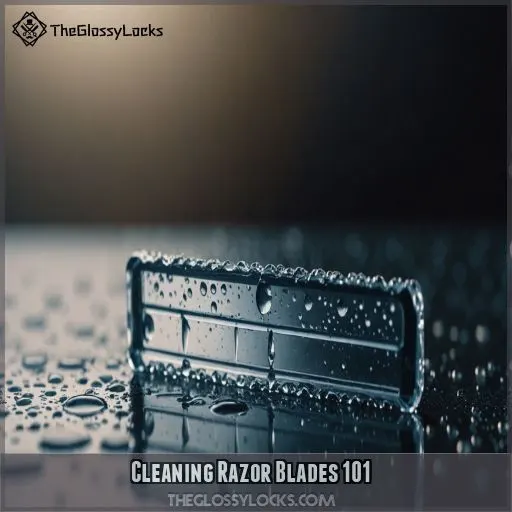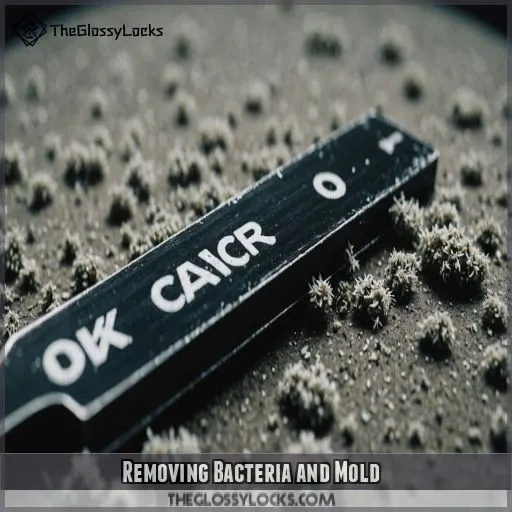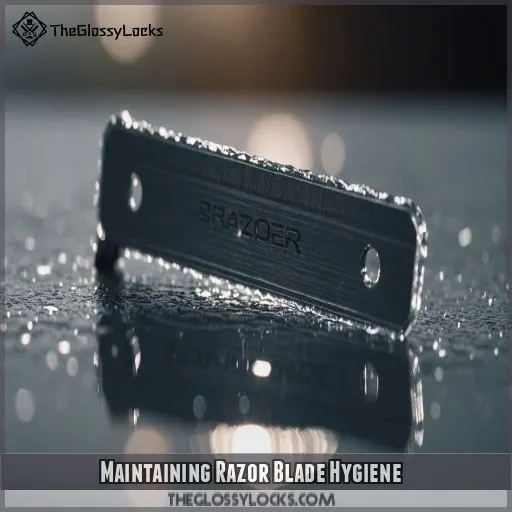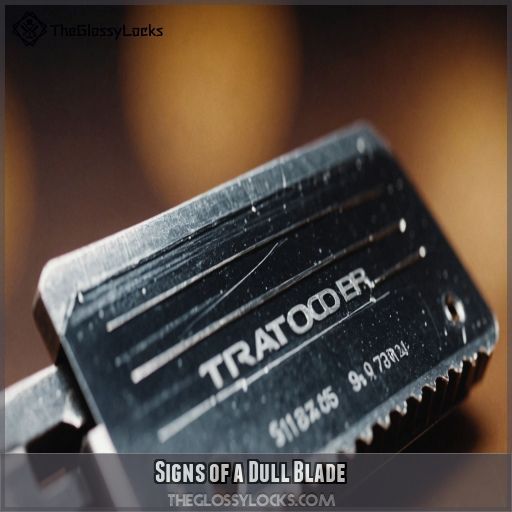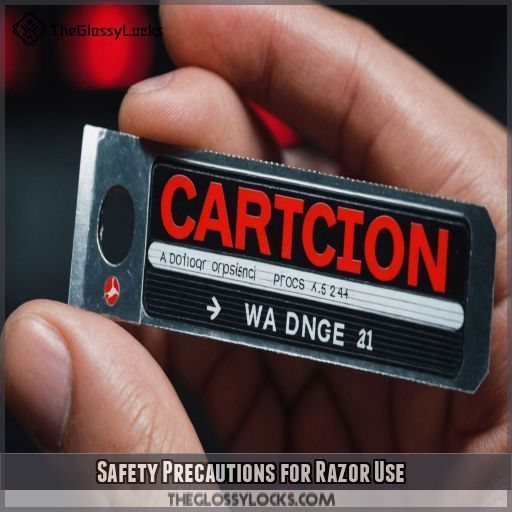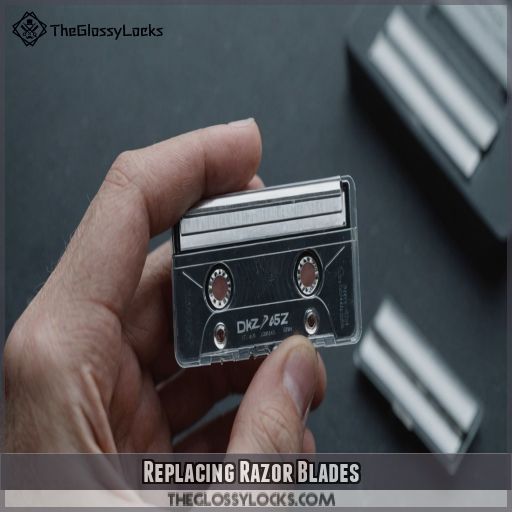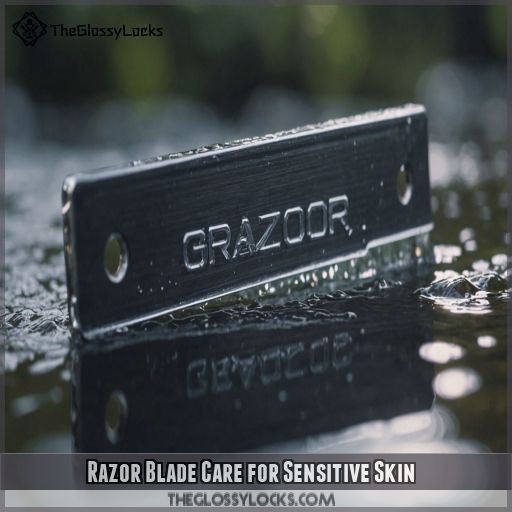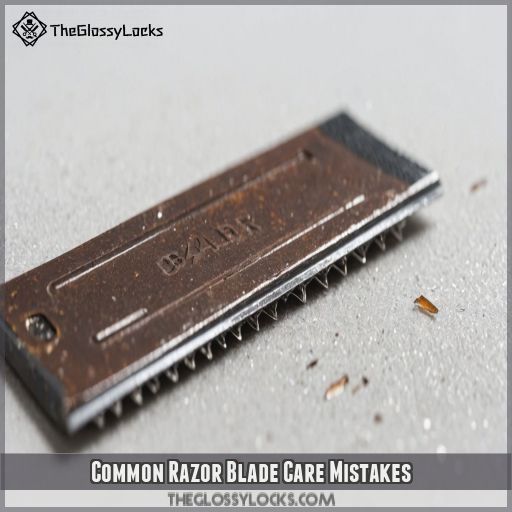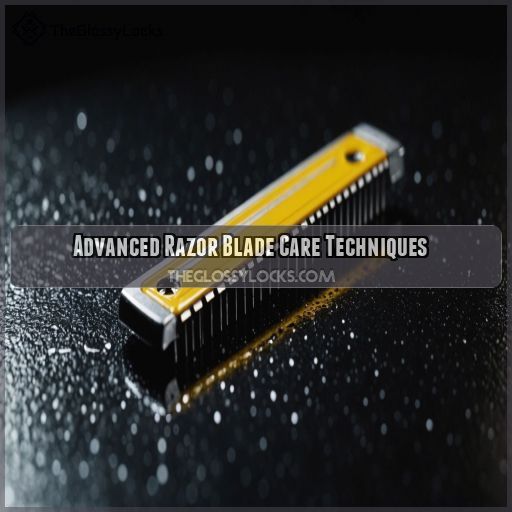This site is supported by our readers. We may earn a commission, at no cost to you, if you purchase through links.
 You want to know the secret to a sharper shave? It starts with cleaning your razor blades at home! Don’t worry, it’s easier than you think.
You want to know the secret to a sharper shave? It starts with cleaning your razor blades at home! Don’t worry, it’s easier than you think.
Simply rinse your blades with hot water after each use, and dry them thoroughly to prevent rust and water spots.
For a deeper clean, soak the razor head in 70% isopropyl alcohol for 5-10 minutes.
And, if you notice any stubborn grime or hair residue, use a soft-bristled razor brush to gently sweep it away.
By following these simple steps, you’ll be on your way to a cleaner, sharper shave.
But, there’s more to it than just cleaning…
Table Of Contents
- Key Takeaways
- Cleaning Razor Blades 101
- Removing Bacteria and Mold
- Maintaining Razor Blade Hygiene
- Signs of a Dull Blade
- Prolonging Blade Life
- Safety Precautions for Razor Use
- Replacing Razor Blades
- Razor Blade Care for Sensitive Skin
- Common Razor Blade Care Mistakes
- Advanced Razor Blade Care Techniques
- Frequently Asked Questions (FAQs)
- Does vinegar clean razor blades?
- How do I keep my razor blades sharp and clean?
- How do you get rid of bacteria in a razor?
- How do you get black mold off a razor?
- How often should I disinfect my razor blades at home?
- Can I use a regular toothbrush to clean my razor?
- What is the best way to dry my razor blades?
- Can I reuse a razor blade after cleaning and disinfecting?
- How do I remove rust from my razor blades at home?
- Conclusion
Key Takeaways
- You’re about to become a razor-cleaning pro! First, get into the habit of rinsing your blades with hot water after each use and dry them thoroughly to prevent rust and water spots. This easy step will make a huge difference in your shave quality.
- Don’t be afraid to get a little aggressive with your cleaning – grab a soft-bristled razor brush and gently scrub those blades to remove any stubborn grime and hair residue. Your skin will thank you for the extra effort!
- You know the saying "an ounce of prevention is worth a pound of cure"? That’s especially true when it comes to disinfecting your razor! Soak the head in isopropyl alcohol or vinegar for 5-10 minutes to kill bacteria and keep your shave game strong.
- Lastly, remember to replace your blades regularly – every 5-10 shaves or when you notice a decline in performance. Your skin will appreciate the fresh start, and you’ll be on your way to a sharper, safer shave in no time!
Cleaning Razor Blades 101
You’re about to learn the secrets to a sharper shave, and it all starts with cleaning your razor blades the right way.
You can say goodbye to razor burn and hello to a smoother you.
In this article, we’ll walk you through the simple steps to keep your blades in top condition, from rinsing and drying techniques to deep cleaning and disinfecting.
Rinsing and Drying Techniques
Let’s explore rinsing and drying techniques. Cleaning your razor is a breeze with the right methods. Here are some tips to get you started:
- Rinse with hot water to remove hair and debris
- Use a drying stand to prevent rust and water spots
- Avoid using towels to dry, as they can cause rust
- Air dry or use a blade cleaning tool for the best results
Using a Razor Brush for Deep Cleaning
Now that you’ve mastered rinsing and drying, it’s time to get a little more aggressive with your cleaning. Grab a razor brush with soft bristles and gently scrub those blades to remove any stubborn grime and hair residue.
Disinfecting With Isopropyl Alcohol
Time to get serious about disinfecting your razor! Soak the head in isopropyl alcohol to kill bacteria. Here are some tips to keep in mind:
- Use a 70% isopropyl alcohol solution for maximum disinfecting power.
- Soak for 5-10 minutes to guarantee thorough sanitizing.
- Rinse thoroughly with hot water to remove any residue.
Removing Bacteria and Mold
You’re probably thinking, "Cleaning my razor blades? Really?" But trust us, removing bacteria and mold is essential for a comfortable shave and to prevent those pesky ingrown hairs and razor burns. By following these simple steps, you’ll be on your way to a cleaner, sharper razor that’ll make shaving a breeze.
Soaking in Vinegar for Sanitization
Soaking your razor in vinegar is a game-changer. Try this:
| Vinegar Solution | Benefits | Duration |
|---|---|---|
| 1 part vinegar, 2 parts water | Sanitizes handles, blades | 30 minutes |
| 1 part vinegar, 1 part water | Natural disinfectant, no harsh chemicals | 1 hour |
| White vinegar | Gentle on surfaces, tough on bacteria | 2 hours |
| Apple cider vinegar Natural Hair Lightener | Soothes skin, reduces irritation | 30 minutes |
Give it a soak and level up your razor care!
Using Hydrogen Peroxide for Disinfection
Now that you’ve soaked your razor in vinegar, it’s time to bring out the big guns – hydrogen peroxide! This common household item is a powerful disinfectant that can help keep your razor clean and bacteria-free.
Preventing Black Mold Growth
Now that you’ve disinfected your razor with hydrogen peroxide, let’s tackle preventing black mold growth. Check out these mold prevention tips to keep your razor fresh and clean:
| Mold Prevention Tips | Humidity Control Methods | Cleaning Solution Options |
|---|---|---|
| Dry your razor thoroughly | Store in a well-ventilated area | Use a mixture of water and baking soda |
| Use a desiccant packet | Avoid storing in humid environments | Try a vinegar and water solution |
| Clean your razor regularly | Use a dehumidifier in your bathroom | Opt for an environmentally-friendly cleaning solution |
Maintaining Razor Blade Hygiene
You’re probably no stranger to the annoyance of razor burn, ingrown hairs, or skin irritation after shaving.
But did you know that maintaining razor blade hygiene can make all the difference?
Storing Razors in Dry Places
When storing your razor, think dry and secure. Keeping your razor in a dry place prevents rust and bacterial growth, extending its lifespan. Consider these storage tips:
- Use a breathable razor case or pouch
- Store in a low-humidity area, like a cabinet
- Avoid storing in the shower or bathroom counter
- Keep it away from direct sunlight and moisture
Avoiding Sharing Razors
Your razor is your own – don’t share it! Sharing razors risks cross-contamination, infections, and razor burn. Keep your shave safe and hygienic by using your own razor and storing it properly.
| Razor Sharing Risks | Infection Prevention Tips | Safe Shaving Practices |
|---|---|---|
| Cross-contamination | Wash hands before shaving | Store razors in dry places |
| Infections | Use clean towels and water | Avoid sharing razors |
| Razor burn | Disinfect razors regularly | Shave in one direction only |
Replacing Blades Regularly
Replacing blades regularly is a no-brainer! Swap them out every 5-10 shaves or when you notice a decline in performance. Check your razor’s maintenance schedule and consider blade refill options for a sharper, safer shave.
Signs of a Dull Blade
You’re probably all too familiar with the dreaded signs of a dull razor blade.
The pulling, the roughness, and the increased irritation can leave you looking and feeling like you’ve been put through a wringer.
Knowing how to recognize these telltale signs is essential, as it’s the first step in restoring your razor to its former glory and getting the smooth shave you deserve.
Recognizing Pulling and Roughness
Now that you’re maintaining your razor blade hygiene, it’s time to watch for signs of a dull blade. Pay attention to pulling and roughness while shaving – these can be early warning signs of blade wear.
Identifying Increased Irritation
Now that you’re on the lookout for pulling and roughness, pay attention to increased irritation – think razor burn, ingrown hairs, and shaving bumps. If your skin’s protesting, it’s likely time to swap out that dull blade.
Checking for Rust and Corrosion
When checking for rust and corrosion, give your razor a once-over. Look for any orange or reddish spots, especially around the blade’s edges. Regularly inspecting your blade helps prevent rust from setting in and keeps your shaves smooth.
Prolonging Blade Life
You’re probably tired of throwing away razor blades that have gone dull way too quickly. By following a few simple steps, you can prolong the life of your razor blades, save some cash, and get a closer shave in the process.
Rinsing Thoroughly After Each Use
Rinse your razor thoroughly after each use with warm water to remove hair and Shaving Cream Residue ensuring good blade lubrication.
, ensuring good blade lubrication. Make it a habit, just like brushing your teeth, to prolong blade life and enjoy a smoother shave.
Using a Plastic Guard for Protection
To safeguard your razor blade, use a plastic guard – it’s like having a protective sidekick! This clever accessory shields the blade from accidental nicks and cuts, prolonging its life and ensuring a safer shave on-the-go.
Replacing Blades After 5-10 Shaves
You’ve mastered using a plastic guard for protection, now it’s time to think about replacing those blades. Here are four signs it’s time for a swap:
- Shave count: You’ve hit 5-10 shaves.
- Dullness: Your razor’s pulling, not gliding.
- Irritation: Ingrown hairs and razor burn are on the rise.
- Rust spots: Yep, it’s time to say goodbye.
Safety Precautions for Razor Use
Mastering the art of razor blade care is important for a safe and enjoyable shaving experience.
Prioritize safety to avoid any nasty nicks or cuts.
Take a few simple precautions:
- Store your razor in a dry place.
- Label it for easy identification.
- Keep disposable razors on hand for guests.
These simple steps will help you shave with confidence and maintain healthy, happy skin.
Preventing Accidents and Injuries
Your razor is a sharp tool – literally! To prevent accidents, store it safely out of reach of kids and pets, and consider a childproof container for travel. Keep those sharp edges from causing harm!
Keeping Disposable Razors on Hand
Keep disposable razors on hand for guests, travel, or emergencies. It’s a thoughtful touch that provides hygiene and comfort. Here are 4 reasons to stock up:
- Guest shaving made easy
- Travel essentials for unexpected delays
- Emergency kit must-haves
- Bathroom essentials for first aid kits
Labeling Razors for Easy Identification
To prevent mix-ups, label your razors for easy identification. Try color-coding or adding fun stickers to personalize your handles. This simple step helps you grab the right razor every time, keeping you safe and in control.
| Razor Labeling Ideas | Benefits |
|---|---|
| Color-coding | Quick identification, prevents mix-ups |
| Fun stickers | Personalizes your razor, adds humor |
| Initials or names | Clear ownership, no confusion |
| Bright tape or bands | Easy to spot, adds visibility |
Replacing Razor Blades
You’re probably thinking it’s time to replace your razor blade, and trust me, your skin will thank you for it. Learning how to choose the right replacement blades and doing it regularly can make all the difference in getting a sharper shave and preventing those pesky ingrown hairs.
Choosing the Right Replacement Blades
When replacing your razor blades, consider the type, price, and lifespan. Look for durable, multi-blade options that provide a close, comfortable shave. Avoid the cheapest blades, as they may not last as long.
Using Razor Blade Refills for Convenience
Now that you’re replacing your razor blades, consider using refills for convenience! Refills offer cost savings and easy installation. Plus, many brands provide various refill options and blade recycling programs, making it a guilt-free choice.
Considering Electric Razors for Ease
Ready to ditch manual razors? Consider switching to electric razors for ease! They reduce shaving time, They reduce shaving time, prevent razor burn causes, and offer travel-friendly convenience.
, and offer travel-friendly convenience. Plus, many come with charging docks, making them a game-changer for your morning routine.
Razor Blade Care for Sensitive Skin
If you’ve got sensitive skin, you know the struggle of finding a razor care routine that doesn’t leave you feeling like you’ve gone through a war. By using gentle cleaning products, avoiding harsh disinfectants, and storing your razor in a cool, dry place, you can keep your skin happy and your shave smooth.
Using Gentle Cleaning Products
Ever wonder how to pamper your razor for sensitive skin? Gently clean it with mild soap options or chemical-free cleaners specifically designed for gentle blade care, and soft brush care to keep it in top shape.
Avoiding Harsh Disinfectants
In the matter of sanitizing your razor, ditch the harsh chemicals! Instead, opt for gentle disinfectant options like vinegar or hydrogen peroxide. Your sensitive skin will thank you for choosing soft sanitizing methods that get the job done.
Storing Razors in Cool, Dry Places
Now that you’re avoiding harsh disinfectants, it’s time to store your razors in a cool, dry place. This is especially important for sensitive skin. Here are some tips to keep your razors fresh:
- Keep them away from direct sunlight
- Store in a breathable case or bag
- Use a dehumidifier to control humidity
- Avoid storing in humid environments, like the bathroom
Common Razor Blade Care Mistakes
You’re probably making a few common tape-in extension mistakes that are dulling your razor blades and sabotaging your shave
. Let’s correct those habits and get you on the path to a sharper, safer shave by identifying the top mistakes to avoid, including not rinsing thoroughly, sharing razors with others, and not drying razors properly.
Not Rinsing Thoroughly
Don’t let a clogged razor head ruin your shave! Failing to rinse thoroughly can lead to soap scum buildup, mineral deposits, and blade damage. Make sure to rinse with warm water to keep your razor in top shape.
Sharing Razors With Others
Don’t even think about sharing your razor with others! Razor sharing risks infection transmission and cross-contamination, compromising personal hygiene and sanitation. Keep your razor to yourself to avoid these nasty consequences and maintain a healthy shaving routine.
Not Drying Razors Properly
The cardinal sin of razor care: not drying your razor properly! This rookie mistake invites rust, corrosion, and a dull blade. Dry your razor thoroughly, paying extra attention to the crevices, to keep it in top shape.
Advanced Razor Blade Care Techniques
You’ve mastered the basics of razor blade care, now it’s time to take your skills to the next level with advanced techniques that’ll make your shave even sharper and safer. Get ready to learn how to use ultrasonic cleaners, UV light sanitizers, and protective cases to keep your razor blades in top condition.
Using Ultrasonic Cleaners for Deep Cleaning
You’re taking razor cleaning to the next level! Using an ultrasonic cleaner can deeply clean your razor, leveraging the cavitation effect to remove grime. Run 1-2 cleaning cycles weekly for the best results, and always follow the manufacturer’s guidelines.
Sanitizing With UV Light
Step up your sanitizing game with UV light! This method is a game-changer for killing bacteria and germs. Simply place your razor under the UV light for a few minutes, and voilà – a germ-free shave every time.
Storing Razors in Protective Cases
Now that you’ve sanitized your razor with UV light, keep it safe and sharp by storing it in a protective case. Choose durable materials like hard plastic or leather to shield your travel razor and maintain blade storage mastery.
Frequently Asked Questions (FAQs)
Does vinegar clean razor blades?
A clean slate is a happy slate!" For razor blades, vinegar is your friend! Soaking your razor in distilled white vinegar can help kill bacteria and remove grime, keeping your blades sharp and clean.
How do I keep my razor blades sharp and clean?
To keep your razor blades sharp and clean, rinse them under hot water after each use, scrub off grime with a brush, and dry thoroughly. Disinfect weekly and replace every 5-10 shaves or when dull.
How do you get rid of bacteria in a razor?
Don’t let bacteria hijack your razor! Soak the head in isopropyl alcohol, distilled white vinegar, or hydrogen peroxide, and swish it vigorously to kill those unwanted guests. Do this once a week for a cleaner, safer shave.
How do you get black mold off a razor?
You’ve got black mold on your razor? Don’t freak out! Soak the razor head in a mixture of equal parts water and white vinegar for 10-15 minutes, then scrub and rinse thoroughly.
How often should I disinfect my razor blades at home?
Think about this: a razor blade, a breeding ground for bacteria. To keep it squeaky clean, disinfect your razor blades at home once a week, swishing them in isopropyl alcohol, vinegar, or hydrogen peroxide for a germ-free shave.
Can I use a regular toothbrush to clean my razor?
You shouldn’t use a regular toothbrush to clean your razor, as it may harbor bacteria. Instead, grab an unused toothbrush or a dedicated razor brush to scrub those blades and keep them squeaky clean.
What is the best way to dry my razor blades?
Did you know 75% of razor-related irritations can be prevented with proper care? To dry your razor blades, simply shake off excess water and air-dry in a well-ventilated area to prevent rust and keep them sharp!
Can I reuse a razor blade after cleaning and disinfecting?
You can reuse a razor blade after cleaning and disinfecting, but don’t expect it to be good as new. Cleaning can’t undo dullness, so replace it if you notice a decline in performance or comfort.
How do I remove rust from my razor blades at home?
You’ve got rusty razor blades
? Don’t worry, it’s an easy fix! Soak them in a mixture of equal parts water and white vinegar for a few hours, then scrub and rinse – good as new!
Conclusion
Cleaning your razor blades at home just became a thousand times easier!
By following these 10 simple steps, you’ll be shaving like a pro in no time.
Don’t forget to store your razors properly and replace those blades when needed.
Mastering how to clean razor blades at home is the key to a smoother, irritation-free shave.

